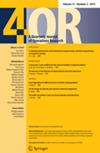Assessment of Subfoveal Choroidal Thickness with SD-OCT in Eyes with Different Stages of Age-Related Macular Degeneration (AMD)
IF 2.6
4区 管理学
Q3 OPERATIONS RESEARCH & MANAGEMENT SCIENCE
引用次数: 0
Abstract
Purpose: The aim of the study was to compare the subfoveal choroidal thickness (SFCT) with the use of Spectral-Domain OCT in eyes with AMD of different stages. Methods: The participants comprised of 30 age-matched normal eyes as controls (Group 1), 19 with early-AMD eyes (Group 2), 14 with intermediate-AMD eyes (Group 3) and 29 with advanced (neovascular) AMD eyes (Group 4). All subjects underwent routine ophthalmologic examination. The choroid images, which included the subfoveal choroidal thickness images, obtained using Spectral-Domain Optical Coherence Tomography (and the technique of Enhanced Depth ImagingEDI). All of the participants volunteered in this study and remained anonymous due to the protection of their personal data. Results: 92 eyes with age greater than 65 years old were included. The mean subfoveal choroidal thickness was 260.93 ± 46.54 μm in age-matched normal eyes, 255.10 ± 44.85 μm in early AMD eyes, 230.92 ± 45.70 μm in intermediate AMD eyes and 206.82 ± 44.43 μm in advanced (neovascular) AMD eyes. There were statistically significant differences in the measurement results Original Research Article Pateras and Kalogeropoulou; OR, 14(3): 6-17, 2021; Article no.OR.68428 7 between the 4th Group with the 1st Group (P<0.0001) and 2nd Group (P=0.0006) respectively, meaning that SFCT was greater in normal and early AMD eyes. Conclusion: Decreasing subfoveal choroidal thickness was demonstrated in the progression of AMD, especially in the advanced AMD eyes compared to normal or early AMD eyes.SD-OCT评价不同阶段老年性黄斑变性(AMD)眼中央凹下脉络膜厚度
目的:比较不同阶段黄斑变性眼的中央凹下脉络膜厚度(SFCT)和光谱域OCT的差异。方法:30只年龄匹配的正常眼作为对照(1组),19只早期黄斑变性眼(2组),14只中度黄斑变性眼(3组),29只晚期(新生血管性)黄斑变性眼(4组)。所有受试者均接受常规眼科检查。脉络膜图像,包括中央凹下脉络膜厚度图像,使用光谱域光学相干断层扫描(和增强深度成像edi技术)获得。所有参与者都是自愿参加这项研究的,为了保护他们的个人数据,他们都是匿名的。结果:纳入92只年龄大于65岁的眼。年龄匹配正常眼中央凹下脉络膜平均厚度为260.93±46.54 μm,早期AMD为255.10±44.85 μm,中期AMD为230.92±45.70 μm,晚期(新生血管性)AMD为206.82±44.43 μm。原研究文章Pateras和Kalogeropoulou的测量结果差异有统计学意义;Or, 14(3): 6- 17,2021;文章no.OR。第4组与第1组比较(P<0.0001),第2组比较(P=0.0006),分别为684287,说明正常和早期AMD眼SFCT更大。结论:与正常或早期黄斑变性眼相比,黄斑变性晚期黄斑变性眼的中央凹下脉络膜厚度明显减少。
本文章由计算机程序翻译,如有差异,请以英文原文为准。
求助全文
约1分钟内获得全文
求助全文
来源期刊

4or-A Quarterly Journal of Operations Research
管理科学-运筹学与管理科学
CiteScore
3.80
自引率
5.00%
发文量
26
审稿时长
6 months
期刊介绍:
4OR - A Quarterly Journal of Operations Research is jointly published by the Belgian, French and Italian Operations Research Societies. It publishes high quality scientific papers on the theory and applications of Operations Research. It is distributed to all individual members of the participating societies.
 求助内容:
求助内容: 应助结果提醒方式:
应助结果提醒方式:


